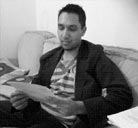http://www.nytimes.com/2006/08/28/world/europe/28plot.html
But interested British readers quickly discovered that they had been denied access to the article. Instead they discovered the following web message:
"This Article Is Unavailable
Even printed copies of the newspaper destined for the UK were scrubbed. Apparently for strictly legal reasons.
In fact, the New York Times' decision to self-censor its own expose from the British readership is, like the "terror plot" itself, more likely to have been based on reasons of political expedience.
Consider, for instance, the confident declaration of Paul Stephenson, deputy chief of the Metropolitan Police in London, that the goal of the apprehended suspects in plotting the attack was "mass murder on an unimaginable scale." Prejudicial to the case Mr. Stephenson? In similar vein, on the very day of the arrests, other officials estimated that as many as 10 planes were to be blown up, possibly over American cities. In Britain, the threat level was raised to its highest, "critical", signalling an imminent terrorist attack, while Home Secretary Dr. John Reid talked repeatedly of the likelihood of an immediate strike. Such pronouncements were repeated in the US. Michael Chertoff, the secretary of the Department of Homeland Security, said that the plot was "getting really quite close to the execution stage."
Let's be clear on this. These were not qualified, tentative descriptions of suspicions about a possible plot. These were definitive, unqualified proclamations about having detected and successfully foiled an imminent al-Qaeda strike to blow up about 10 civilian planes using liquid explosives to be manufactured on board. So much so that Dr. Reid was rebuked by the Attorney-General for possibly prejudicing the trial of the arrested individuals.
Possibly?
My own research of public record sources published Monday 21st August, "The Truth about the 'Terror Plot'... and the new pseudo-terrorism", fundamentally undermines the official narrative. My findings, like that of the NY Times article, do not prejudice any trial -- but they do prejudice the standards of political convenience adopted by British and American officials, whereby their repeated distortions, exaggerations and outright fabrications about the "terror plot" have been used to justify government attempts to push for suspension of sections of the Human Rights Act 1998, and to drastically increase draconian anti-terror powers.
For this reason, publication of the latest evidence undermining the government's prejudicial claims serves not to create further prejudice, but to correct the lies and distortions that have already been widely disseminated and swallowed whole by an increasingly pathetic and subservient media, that remains unable to learn from the pattern of deceit long established in examples like the non-existent "Ricin Plot" (as former British Ambassador Craig Murray says, "there was no ricin; and there was no plot"). What the new evidence, indeed, demonstrates quite clearly, is that the British government, deliberately, consciously, pretended that there was an imminent threat from a plot which, it knew all too well, barely existed.
Therefore, for reasons of urgent public interest and in order to help correct the prejudicial distortions printed and aired repeatedly by the media on the basis of the false statements of our purported political representatives, I am posting the New York Times article in full, online, for the first time (see Annex below). And I would urge you all to re-post everywhere you can.
A number of points within the article, however, are worth highlighting. The New York Times points out, for instance, that according to "five senior British officials... the suspects were not prepared to strike immediately. Instead, the reactions of Britain and the United States in the wake of the arrests of 21 people on Aug. 10 were driven less by information about a specific, imminent attack than fear that other, unknown terrorists might strike."
Unfortunately, this "fear" also had little basis in actual evidence. Consider the fact that "British officials said the suspects still had a lot of work to do. Two of the suspects did not have passports, but had applied for expedited approval." One of the men had apparently looked up airline schedules for flights from London to the US (a crime for any British Muslim?), but investigators confirmed that "the suspects had neither made reservations nor purchased plane tickets." Supposed "bomb-making equipment" described blandly as "chemicals" and "electrical components" (meaning household products and MP3 players) was found "five days after the
arrests," not before.
"In fact," continues the NY Times, "two and a half weeks since the inquiry became public, British investigators have still not determined whether there was a target date for the attacks or how many planes were to be involved. They say the estimate of 10 planes was speculative and exaggerated."
(Note: You can view every article as one long page if you sign up as an Advocate Member, or higher).





